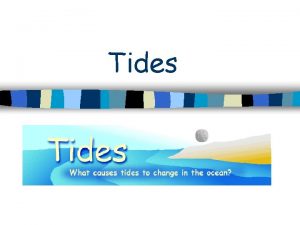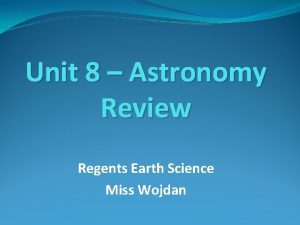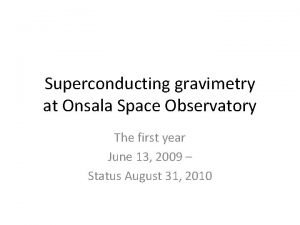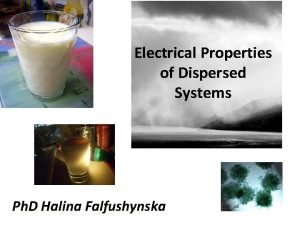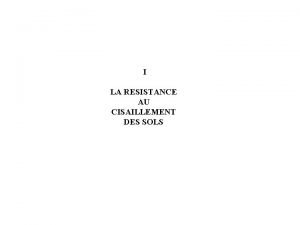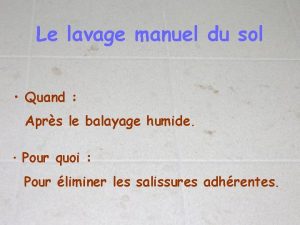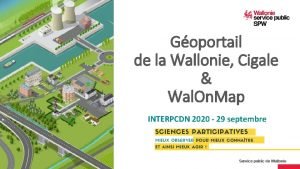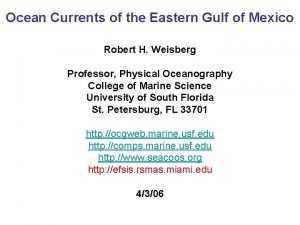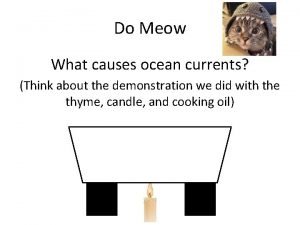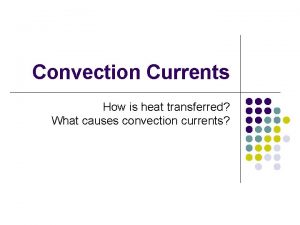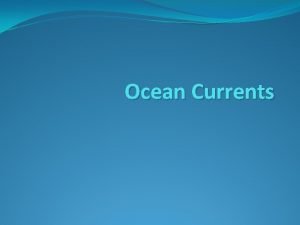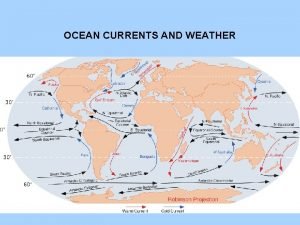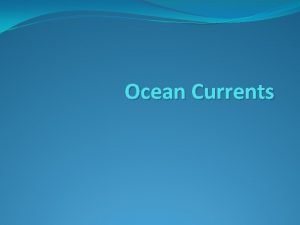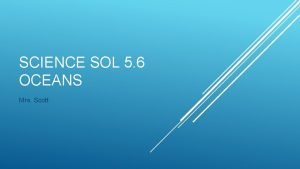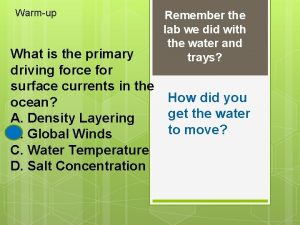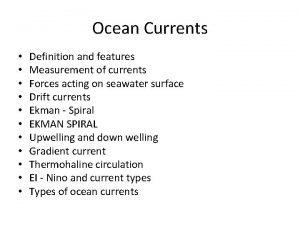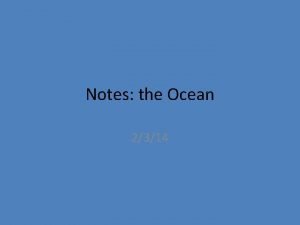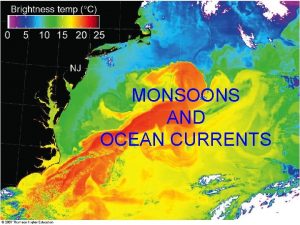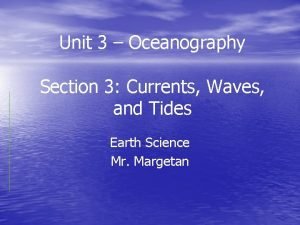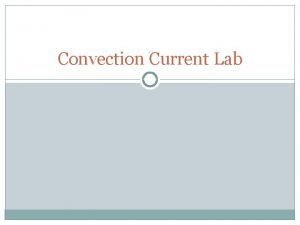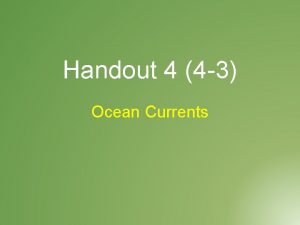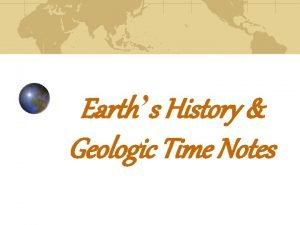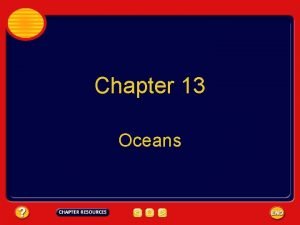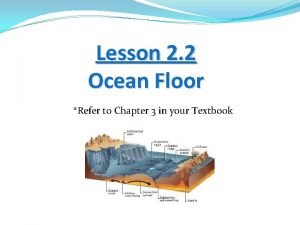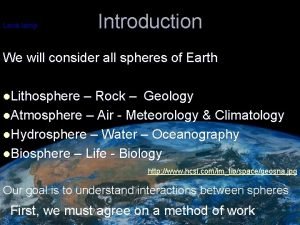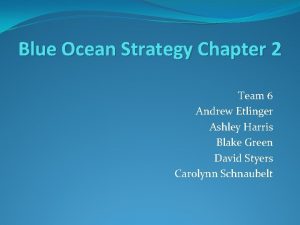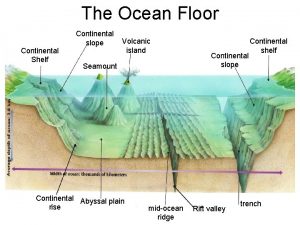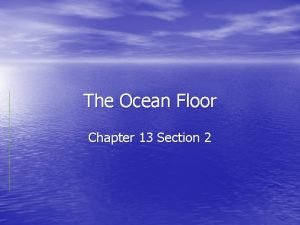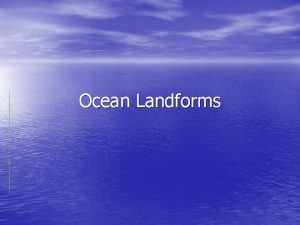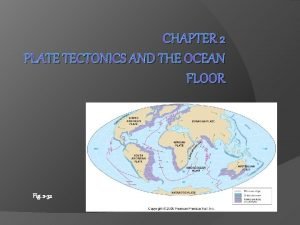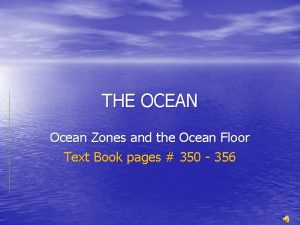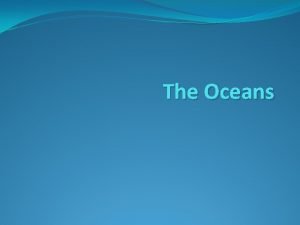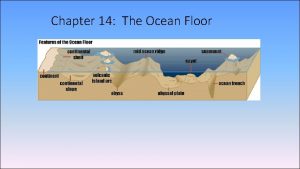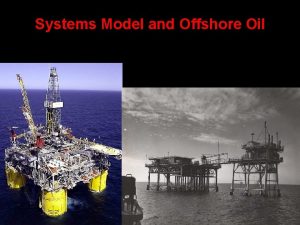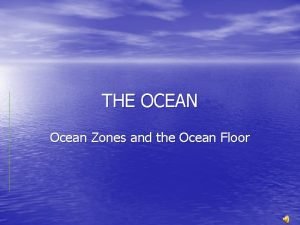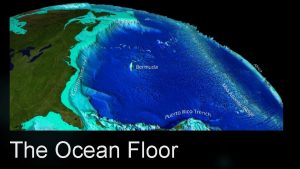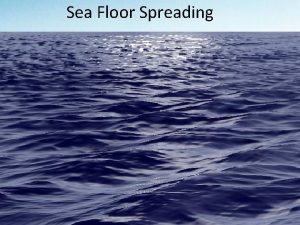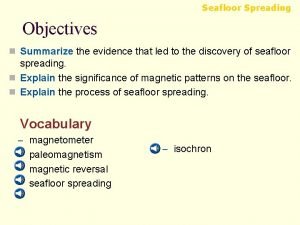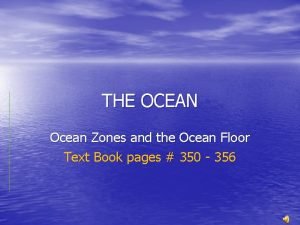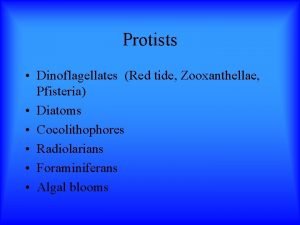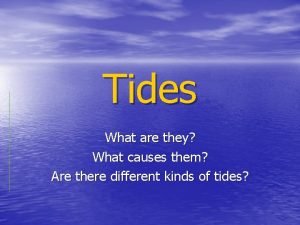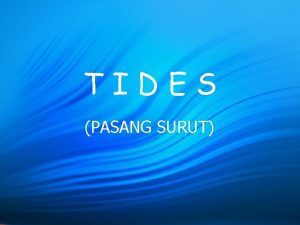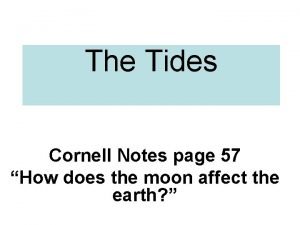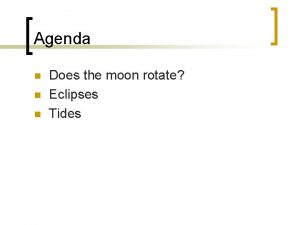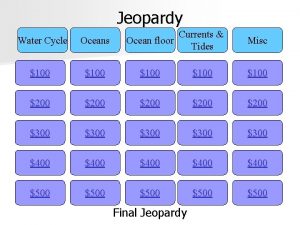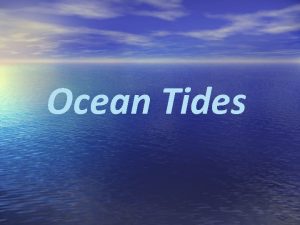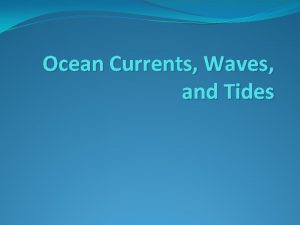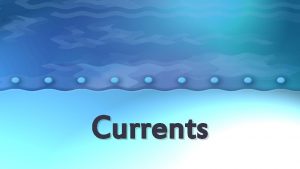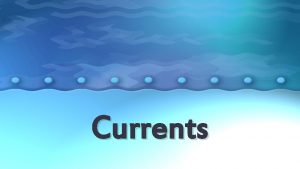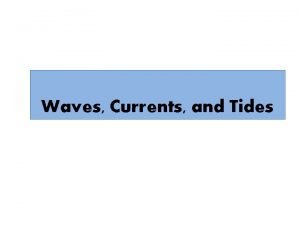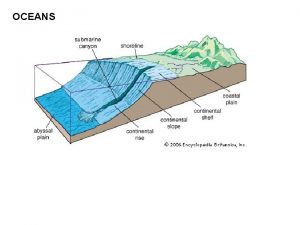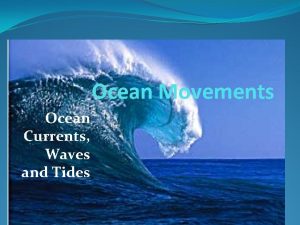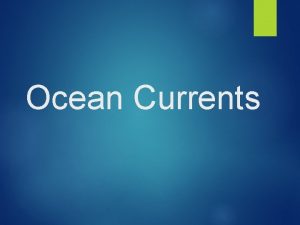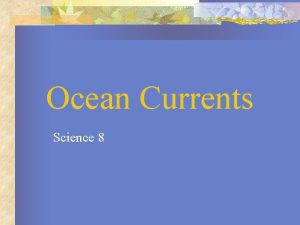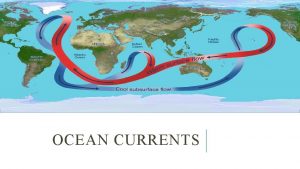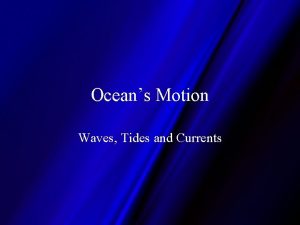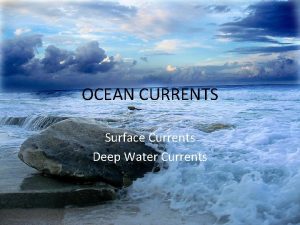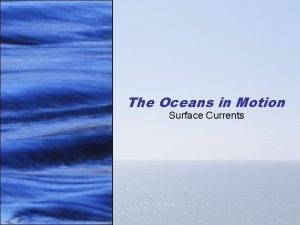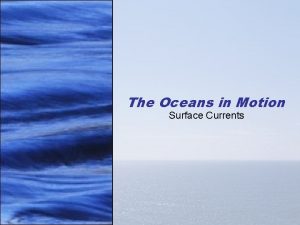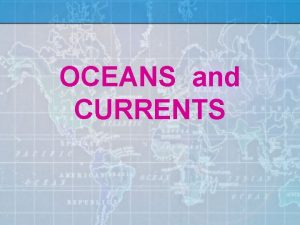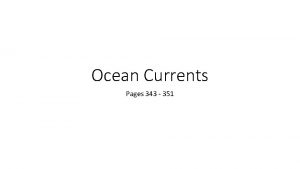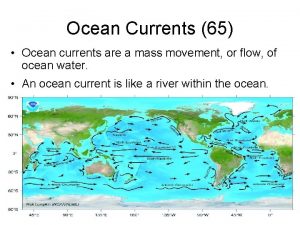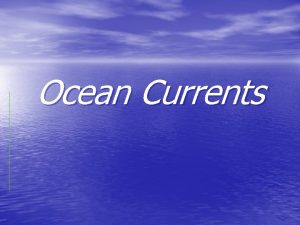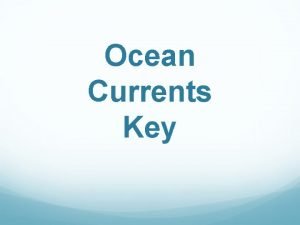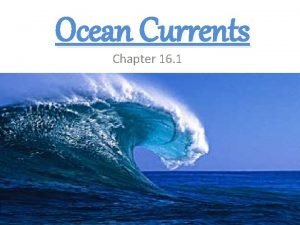Oceans Ocean floor currents tides ecosystem VA SOLs



























































- Slides: 59

Oceans Ocean floor, currents, tides, ecosystem

VA SOLs 4 -6 th grade 6. 8 The student will investigate and understand the organization of the solar system and the relationships among the various bodies that comprise it: the unique properties of Earth as a planet; & the cause of tides. • 5. 6 The student will investigate and understand characteristics of the ocean environment. Key concepts include 1. geological characteristics (continental shelf, slope, rise); 2. physical characteristics (depth, salinity, major currents); and 3. biological characteristics (ecosystems) • 4. 5 The student will investigate and understand how plants and animals in an ecosystem interact with one another and the nonliving environment: behavioral and structural adaptations; flow of energy through food webs. •

Ocean facts • Over 70% of the Earth's surface is covered with water and the oceans contain 97% of all water on Earth.

The four oceans? • There is only one ocean. The four oceans of the world are: the Arctic, the Indian, the Pacific, and the Atlantic. They are all connected to each other.

Where does ocean water come from? • From watersheds. Rain, tiny streams, roaring rivers all eventually lead to an ocean and contribute water.

Water cycle • The water cycle, kept in action by the sun, moves water to and from the oceans. Ocean water makes up 80% of all water evaporated.

Erosion • Erosion can occur and more than water leaves the watershed. • You can play the watershed game at • http: //www. bellmuse um. umn. edu/games/ watershed/

Delta • When a large river dumps eroded material into the ocean, a rise or small hill can form.

Delta • Many factors can cause erosion which causes a delta to form.

Amazon delta • The Amazon River, where piranha live, has a cone shaped deposit from many tons of debris being washed into the ocean during the rainy season.

Matching • What cycle moves water? The ____ • Where does most of the water evaporated come from? • When erosion dumps sand, soil, etc at the mouth of a river it is called a _______ Water cycle Delta Oceans

The ocean floor What is on the floor of the ocean? How is the area divided up?

Continental shelf • Beginning at the shore line, the continental shelf stretches toward deeper parts of the ocean. • When soil and other eroded materials are washed to the ocean, the shelf forms.

Continental shelf • The most organisms can be found here because sunlight is available for plants and many nutrients are washed from land onto the shelf.

Continental shelf • The shelf is widest in the area of Russia known as Siberia. It stretches almost 1000 miles into the Arctic Ocean. • Florida has hardly any shelf because the Gulf Stream whisks it away.

Continental slope • When the continental shelf suddenly gets much steeper, it is called the continental slope. • Water pressure increases and fewer organisms live here.

Continental slope • Bioluminescence, light given off by living organisms, helps creatures survive where little or no sunlight penetrates.

Continental rise • Between the deepest part of the ocean and the continental slope you would find • The continental rise. Very little light penetrates thus few animals or plants can survive.

Abyssal Plains • Deep, deep in the ocean no light penetrates making the water dark as night and cold. The pressure is great. Few things can live under such conditions.

Abyssal Plains • Although most of the plains are smooth and flat, hot vents stick up like chimneys and trenches deeper than the Grand Canyon can be found.

Abyssal Plains • • • Clams Tubeworms Spider crabs Strange fish Bacteria These creatures can survive near the hot vents because they have both heat and mineral rich water.

Matching • What is the lowest level of the ocean floor called? • In which are would you find the most animal and plant life? Abyssal Plains Continental shelf Continental rise Continental slope

Matching • What is the lowest level of the ocean floor called? • Abyssal Plains • In which are would you find the most animal and plant life? • Continental shelf

Internet Resources • http: //www. harcourtschool. com/activity/scien ce_up_close/518/deploy/interface. html features of the ocean floor

Animal adaptations • Fish have body parts that help them move and breathe in water. • Jellyfish have stinging cells to capture prey.

Ocean Vertebrates • Vertebrates have backbones. • Turtles are reptiles. Most lay their eggs on land. The hatchlings must get to the ocean on their own.

Ocean Vertebrates • Vertebrates, like the dugong, have backbones. This animal is a mammal and must breathe air to survive like dolphins and whales.

Ocean Vertebrates • Vertebrates have backbones. Many are carnivores. Seahorses are not really horses.

Pollution in the Ocean • Cutting the plastic six-pack rings saves sea life from getting caught in them. If trash is not put in the right place, it can find its way to the ocean, where it is harmful to all sea life.

Coral reefs Invertebrates • Invertebrates have no backbone. Sponges and starfish are invertebrates.

Ocean Invertebrates • Crabs are crustaceans and clams are mollusks. Both are invertebrates. Crabs spend most of their lives on land near the ocean.

BBC resources • http: //www. bbc. co. uk/nature/blueplanet/blue/fl ash/main_game. shtml journey to the deep • http: //www. bbc. co. uk/nature/blueplanet/alien/t easer. shtml Under pressure – who can survive in the deep? • http: //www. bbc. co. uk/nature/blueplanet/webs/fl ash/teaser. shtml Friend or foe?

Ocean food chain questions • What animal is at the top of the chain? • Which is at the bottom? • Who eats smaller fish?

Ocean food chain answers • What animal is at the top of the chain? • Whale/mammal • Which is at the bottom? • Phytoplankton • Who eats smaller fish? • Bigger fish.

Ocean interaction • Does the Arctic food chain/web depend on the ocean? • See http: //www. harcourtschool. com/activity/food/arctic_a ctivity. html to do this interactive

Ocean food web The ocean food web includes land animals and birds that eat producers and lower level consumers that live in the ocean.

Ocean food web questions Which animal is at the top of the food web? What do phytoplankton need to survive?

Ocean food web answers Which animal is at the top of the food web? Fox What do phytoplankton need to survive? Sun, air, water, nutrients

Ocean food web questions If many salmon die from over fishing, what will happen to the zooplankton and why? What will happen to the puffins and why?

Ocean food web questions If many salmon die from over fishing, the zooplankton will increase. cephalopods and sand lances will have more to eat. The puffins will have less salmon to eat and will eat more cephalopods and sand lances.

Ocean pollution in Alaska Mercury , a toxic chemical, is released into the air from burning coal. What is a small amount in the krill that eat it accumulates and concentrates in the fish further up the food chain. Finally people eat the albacore, halibut, etc where it is the most concentrated. They become ill because mercury can affect the nervous, immune and reproductive systems. It can damage unborn babies. Even though Alaska produces little mercury, toxic levels in some fish because mercury travels through the atmosphere and oceans.

Coral reefs • Coral reefs are an amazing ecosystems and can be thought of as the rainforests of the sea Their great biological diversity of thousands of species make them the most complex, populated and productive of marine ecosystem.

Internet Resources • http: //www. harcourtschool. com/activity/scien ce_up_close/609/deploy/interface. html explore a coral reef

Internet Resources • Check out this interactive at • http: //www. ed uplace. com/kid s/hmsc/activiti es/simulations/ gr 1/unitb. html

How ocean currents work • Water varies in density because of temperature and salinity (how much salt is dissolved in sea water). • Saltier water is more dense than less salty water • Cold water is more dense than warm water.

How ocean currents work • Denser water tends to sink, while less dense water tends to rise so cold-water currents move sinking cold water from the poles toward the equator. • Warm-water currents travel from the equator along the surface, toward the poles to replace the sinking cold water.

Ocean currents Northern hemisphere • Red is warmer water, blue is colder from the North Pole.

Gulf Stream • The Gulf Stream moves through the Gulf of Mexico, past the east coast of the US and over to Northern Europe. Without the strong, warm Gulf Stream, England other places in Europe would be as cold as Canada.

Gulf Stream • Ben Franklin investigated the Gulf Stream. "This Stream is probably generated by the accumulation of water on the eastern coast of America between the tropics, by the trade winds that constantly blow there. . . " • He figured out it slowed as it flowed north, but stayed warmer than the rest of the North Atlantic.

Internet resources • http: //www. k 12 science. org/curriculum/gulfstream/i ndex. shtml Gulf Stream Voyage -online multidisciplinary project using real time data and primary sources.

Tides • Tides are the vertical rising and lowering of sea level. The gravitational pull of the sun and moon affect the tides but although the sun has a stronger pull, the moon is closer and pulls twice as hard. Try a tide activity using charts http: //www. mbgnet. net/salt/sandy/indexfr. htm

Tides • New or full moons combine with the sun to make high tides very high and the low tides very low. This is called a spring high tide. • When the moon is in quarter phases the sun and moon cancel each other making neap tides when there is little difference between high and low tide.

Questions • What current flows from North America to Europe? • Which moon phases make the highest tides and why? The lowest? • Which sinks more: salt water or fresh? Cold or warm?

Questions • • What current flows from North America to Europe? Gulf Stream • • Which moon phases make the highest tides and why? Full and new moon – gravity of sun and moon combine. • • Which moon phases make the lowest? Quarter moons because the sun and moon pull against each other. • • Which sinks more: salt water or fresh? Cold or warm? Salty and cold

Internet Resources • http: //www. mhschool. com/science/2005/studen t/activity/crossword/sci_gr 2_ch 04. html a primary level crossword puzzle • http: //www. eduplace. com/science/hmsc/conten t/organizer/6/org_6 d_12_3. pdf graphic organizer showing cause and effect for tides. • http: //library. thinkquest. org/J 001597/kjsimfp. ht ml Can you keep a shark alive? • http: //eclassroom. 110 mb. com/5 th. Science/ocean s. html Fling the teacher review game

Internet Resources http: //www. bbc. co. uk/nature/ blueplanet/edge/flash/teaser. s html control the waves game from BBC http: //highered. mcgrawhill. com/sites/0072402466/student_view 0/chapter 12/animations_and_movies. html How do glaciers form and move? • http: //activities. macmillanmh. com/science/c a/grade 3/g 3_ch 2_ls 2_ereview. html • How do plants survive in the ocean?

Ocean webquests • • http: //peoria. k 12. il. us/shwhite/Ocean. WQ. html An adventure exploring the last frontier on Earth. Uncover the oceans' mysteries hidden deep beneath the surface and report your findings. http: //www. kmuska. com/oceanx. html “You and your team have been selected to be part of the crew on the ship, Detective Divers. You will be exploring the oceans to learn about coral reef ecosystems. ” http: //chalk. richmond. edu/education/projects/webquests/oceans/ Pollution is harmful to everything, especially oceans. Your investigation team will research pollution's impact on the ocean and pollution solutions in order to convince the town of Polluterville to stop polluting. http: //www. schenectady. k 12. ny. us/users/title 3/future%20 grant%20 projects/Pr ojects/ocean. html Ready, set, dive!! Build an aquarium for ocean animals by investigating what an animal looks like, where it lives, what it eats, and who eats it!

What does this graphic explain? Hint: the root word “thermo” means….

What does this graphic explain? Hint: the root word “thermo” means heat so this graphic describes how water temperature differs by latitude.
 Ocean currents waves and tides
Ocean currents waves and tides High tide
High tide Periodic rise and fall of sea level
Periodic rise and fall of sea level What is deep current
What is deep current Ocean tides observed at coastal locations
Ocean tides observed at coastal locations Ocean tides
Ocean tides Electrophoresis in colloidal solution
Electrophoresis in colloidal solution Cisaillement des sols
Cisaillement des sols Lavage manuel des sols
Lavage manuel des sols Wallonie on map
Wallonie on map Ocean currents gulf of mexico
Ocean currents gulf of mexico Climate types brainpop
Climate types brainpop What are ocean currents
What are ocean currents What causes convection currents
What causes convection currents Current
Current Gyre
Gyre Ocean currents vocabulary
Ocean currents vocabulary Midnight zone
Midnight zone Factors affecting their climate
Factors affecting their climate What is the primary driving force of surface-ocean currents
What is the primary driving force of surface-ocean currents Ocean currents definition
Ocean currents definition What are ocean currents
What are ocean currents Ocean currents
Ocean currents Ocean currents
Ocean currents Rubber ducks ocean currents activity
Rubber ducks ocean currents activity Convection current lab
Convection current lab Surface ocean currents
Surface ocean currents Ocean currents project
Ocean currents project Cold peruvian current
Cold peruvian current Convergent oceanic oceanic plate boundary
Convergent oceanic oceanic plate boundary Convergent transform
Convergent transform Ocean ocean convergent boundary
Ocean ocean convergent boundary Red and blue ocean strategy
Red and blue ocean strategy Chapter 15 ocean water and ocean life wordwise answer key
Chapter 15 ocean water and ocean life wordwise answer key Ocean ocean convergent boundary
Ocean ocean convergent boundary Convergent plate boundary
Convergent plate boundary Convergent plate boundaries
Convergent plate boundaries Ocean basin
Ocean basin Ocean floor lava lamp
Ocean floor lava lamp Blue ocean floor
Blue ocean floor Continental margins
Continental margins Deep valley on the ocean floor
Deep valley on the ocean floor What is the flattest part of the ocean floor
What is the flattest part of the ocean floor From now
From now Ocean floor
Ocean floor Ocean floor features
Ocean floor features What is sea-floor spreading? *
What is sea-floor spreading? * Chapter 14 the ocean floor worksheet answers
Chapter 14 the ocean floor worksheet answers How are oil rigs anchored to the ocean floor
How are oil rigs anchored to the ocean floor Slidetodoc.com
Slidetodoc.com Ocean floor
Ocean floor Seafloor spreading diagram
Seafloor spreading diagram Isochron map of ocean-floor crust worksheet answers
Isochron map of ocean-floor crust worksheet answers The deep ocean floor that is nearly flat
The deep ocean floor that is nearly flat Phylum actinopoda
Phylum actinopoda What is a dream
What is a dream Tides adalah
Tides adalah Spring tides
Spring tides Cooper river tides
Cooper river tides What are tides?
What are tides?


